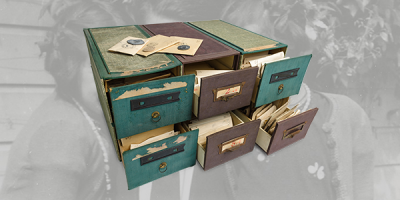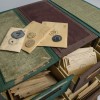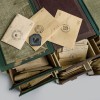File Cabinets with Stamps
From the collection of the Resistance Museum Amsterdam

Per box:
h 12 cm x w 16 cm
1943-1945
Thanks to these rubber stamps – stored in envelopes arranged alphabetically in these cabinets – it was possible to create fake identity cards and other documents during the war. Exactly how many were forged is unknown, but by the beginning of 1944 the count was already 91,000.




The Persoonsbewijzencentrale (PBC, Central Office for Identity Cards) was established in 1942 by the Dutch sculptor Gerrit van der Veen, an inventive and resourceful man. The PBC grew into the largest counterfeiting organization in the Netherlands. False identity papers were indispensable for both the Resistance and people who had to go into hiding. The PBC provided forgeries on request, mostly to their colleagues working in the illegal underground. Identity cards and ration cards had to have the proper stamps. Therefore, the PBC made copies of hundreds of official stamps. It grew into a kind of industry: starting in 1944, approximately one hundred people including many professionals such as the printer Frans Duwaer worked at this on a daily basis. Gerrit van der Veen was arrested on 12 May 1944. He was sentenced to death on 10 June 1944 along with six others, including Duwaer. They were all executed the same day by firing squad in the dunes near the town of Overveen.




